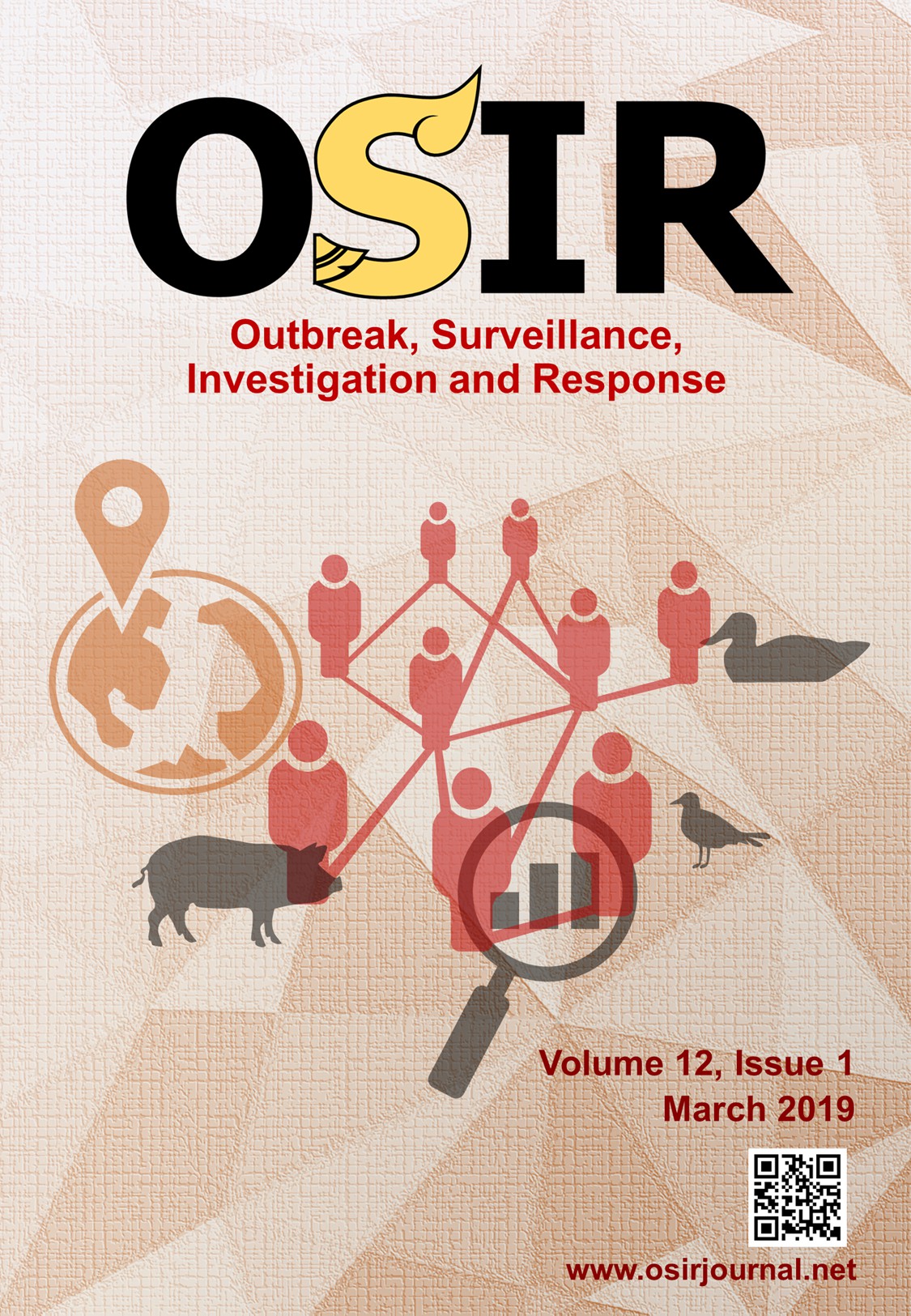Systemic Investigation of Dengue Incidence and Control Measures in Surin, Thailand, 2018
DOI:
https://doi.org/10.59096/osir.v12i1.263019Keywords:
Dengue, system investigation, Breteau index, house index, container index, integrated vector managementAbstract
This study aimed to explore the situation of dengue outbreak in Surin, a province in the Northeast of Thailand, and its control measures, and determine the association between entomological indices and dengue incidence in 2018. A cross-sectional mixed-methods design was used. Document review, primary survey and in-depth interviews were performed. A survey was conducted in 17 subdistricts. Descriptive statistics and multivariable Poisson regression were exercised in quantitative data. Thematic coding was applied in qualitative data. The attack rate between 1 January 2018 and 28 July 2018 was 72.3 cases per 100,000 population. The outbreak was pronounced during June-July 2018, with no reported deaths. Most cases were children aged below 15 years. Dengue fever was the most common diagnosis. The survey found positive association between Breteau index and attack rate. Regarding control measures, most fogging used a single chemical instead of mixed chemicals. Some local providers flagged difficulties in operationalizing the control measures, resulted from resource-mobilization constraints and opposition from some local inhabitants. Intensifying larva elimination campaigns and switching the fogging method from single chemical to mixed chemicals were recommended. A participatory public policy process should be initiated to identify effective vector-control strategies that are in line with the inhabitants’ living norms.
References
Guzman MG, Halstead SB, Artsob H, Buchy P, Farrar J, Gubler DJ, et al. Dengue: a continuing global threat. Nat Rev Microbiol. 2010 Dec;8(12 Suppl):S7-16.
Simmons CP, Farrar JJ, Nguyen v V, Wills B. Dengue. N Engl J Med. 2012 Apr 12;366(15):1423-32.
Powell JR, Tabachnick WJ. History of domestication and spread of Aedes aegypti – A Review. Memórias do Instituto Oswaldo Cruz. 2013;108(Suppl 1):11-7.
Srikiatkhachorn A, Rothman AL, Gibbons RV, Sittisombut N, Malasit P, Ennis FA, et al. Dengue—how best to classify it. Clinical Infectious Diseases: An Official Publication of the Infectious Diseases Society of America. 2011;53(6):563-7.
Bhatt S, Gething PW, Brady OJ, Messina JP, Farlow AW, Moyes CL, et al. The global distribution and burden of dengue. Nature. 2013;496:504.
Limkittikul K, Brett J, L'Azou M. Epidemiological trends of dengue disease in Thailand (2000-2011): a systematic literature review. PLoS Neglected Tropical Diseases. 2014;8(11):e3241.
Chareonsook O, Foy HM, Teeraratkul A, Silarug N. Changing epidemiology of dengue hemorrhagic fever in Thailand. Epidemiol Infect. 1999 Feb;122(1):161-6.
Thailand. Bureau of Vector Borne Diseases. Department of Disease Control. Ministry of Public Health. Dengue control measures: 3,3,1–7–14–21–28. Nonthaburi: Department of Disease Control, Thailand; 2013 [cited 2018 Sep 14]. <http://www.thaivbd.org/n/contents/view/325289>
World Health Organization. Handbook for integrated vector management. Geneva: World Health Organization; 2012 [cited 2018 Sep 14]. <http://apps.who.int/iris/bitstream/handle/10665/44768/9789241502801_eng.pdf;jsessionid=F994FC4765D80E6A920D58C6BF685761?sequence=1>
Focks D. A review of entomological sampling methods and indicators for dengue vectors. Geneva: World Health Organization; 2003 [cited 2018 Sep 14]. <http://apps.who.int/iris/bitstream/handle/10665/68575/TDR_IDE_DEN_03.1.pdf?sequence=1>
Bowman LR, Runge-Ranzinger S, McCall PJ. Assessing the relationship between vector indices and dengue transmission: a systematic review of the evidence. PLoS Negl Trop Dis. 2014 May;8(5):e2848.
Wongbutdee J, Saengnill W. Aedes aegypti larval habitats and dengue vector indices in a village of Ubonratchathani in the North-East of Thailand. Res J. 2015;20(2):254-9.
Thailand. Bureau of Vector Borne Diseases. Department of Disease Control. Ministry of Public Health. Dengue: container index and house index. Nonthaburi: Department of Disease Control, Thailand; 2016. Thai [cited 2018 Sep 14]. <https://phdb.moph.go.th/phdb2017/force_down.php?f_id=194>
Epidemiology Unit. Dengue situation during epidemiological week 29. Surin: Surin Provincial Health Office; 2018. 15. Thailand. Bureau of Epidemiology. Department of Disease Control. Ministry of Public Health. Reporting of priority diseases guideline, Thailand. Nonthaburi: Department of Disease Control, Thailand; 2012. Thai.
Thailand. Bureau of Vector Borne Diseases. Department of Disease Control. Ministry of Public Health. Larva survey for dengue vector control. Nonthaburi: Department of Disease Control, Thailand; 2013 [cited 2018 Sep 14]. <http://www.thaivbd.org/n/contents/view/324792>
Srikiatkhachorn A, Krautrachue A, Ratanaprakarn W, Wongtapradit L, Nithipanya N, Kalayanarooj S, et al. Natural history of plasma leakage in dengue hemorrhagic fever: a serial ultrasonographic study. Pediatr Infect Dis J. 2007;26(4):283-90.
Kasai S, Komagata O, Itokawa K, Shono T, Ng LC, Kobayashi M, et al. Mechanisms of pyrethroid resistance in the dengue mosquito vector, Aedes aegypti: target site insensitivity, penetration, and metabolism. PLoS Negl Trop Dis. 2014 Jun;8(6):e2948.
Chuaycharoensuk T, Juntarajumnong W, Boonyuan W, Bangs MJ, Akratanakul P, Thammapalo S, et al. Frequency of pyrethroid resistance in Aedes aegypti and Aedes albopictus (Diptera: Culicidae) in Thailand. J Vector Ecol. 2011 Jun;36(1):204-12.
Basker P, Kolandaswamy KG. Study on the behavior of dengue viruses during outbreaks with reference to entomological and laboratory surveillance in the Cuddalore, Nagapattinam, and Tirunelveli Districts of Tamil Nadu, India. Osong Public Health and Research Perspectives. 2015 Jun 1;6(3):143-58.
Sanchez L, Vanlerberghe V, Alfonso L, Marquetti MdC, Guzman MG, Bisset J, et al. Aedes aegypti larval indices and risk for dengue epidemics. Emerging Infectious Diseases. 2006;12(5):800-6.
Murray NEA, Quam MB, Wilder-Smith A. Epidemiology of dengue: past, present and future prospects. Clinical Epidemiology. 2013;5:299-309.
Downloads
Published
How to Cite
Issue
Section
License
Copyright (c) 2023 Outbreak, Surveillance, Investigation & Response (OSIR) Journal

This work is licensed under a Creative Commons Attribution-NonCommercial-NoDerivatives 4.0 International License.









